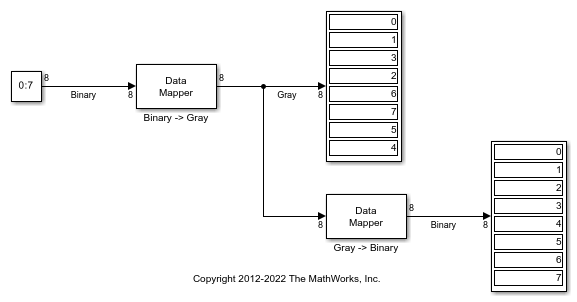Data Mapper
Map integer symbols from one coding scheme to another
Libraries:
Communications Toolbox /
Utility Blocks
Description
The Data Mapper block accepts integer inputs and maps them to integer outputs. The mapping types include: binary to Gray coded, Gray coded to binary, and user defined. Additionally, a pass through option is available.
Gray coding is an ordering of binary numbers such that all adjacent numbers differ by only one bit.
Examples
Binary to Gray Conversion in Simulink
The doc_binary2gray model converts a binary sequence to a Gray-coded sequence and vice versa by using Data Mapper blocks.
Run the model.
The Display blocks show the binary-coded and Gray-coded sequence ordering.

Ports
Input
Port_1 — Input port
scalar | column vector | matrix
Input signal, specified as a scalar, vector, or matrix of integers. Elements of the input signal must be nonnegative values. The block truncates noninteger values to integer values. When the input is a matrix, the columns are treated as independent channels.
Data Types: double | single | int8 | int16 | int32 | uint8 | uint16 | uint32
Output
Port_2 — Output signal
scalar | column vector | matrix
Output signal, returned as a scalar, column vector, or matrix. The dimensions of the output signal match those of the input signal.
Data Types: double | single | int8 | int16 | int32 | uint8 | uint16 | uint32
Parameters
To edit block parameters interactively, use the Property Inspector. From the Simulink® Toolstrip, on the Simulation tab, in the Prepare gallery, select Property Inspector.
Mapping mode — Mapping mode
Binary to Gray (default) | Gray to Binary | User Defined | Straight through
Mapping mode, specified as one of the four options. The mapping for the
Binary to Gray and the Gray to
Binary modes are shown in the following table when the
inputs range from 0 to 7.
| Binary to Gray Mode | Gray to Binary Mode | ||
|---|---|---|---|
| Input | Output | Input | Output |
| 0 | 0 (000) | 0 (000) | 0 |
| 1 | 1 (001) | 1 (001) | 1 |
| 2 | 3 (011) | 2 (010) | 3 |
| 3 | 2 (010) | 3 (011) | 2 |
| 4 | 6 (110) | 4 (100) | 7 |
| 5 | 7 (111) | 5 (101) | 6 |
| 6 | 5 (101) | 6 (110) | 4 |
| 7 | 4 (100) | 7 (111) | 5 |
When you select the User Defined mode, you can
use any arbitrary mapping by providing a vector to specify the output
ordering. When you select the Straight Through
mode, the output equals the input.
Symbol set size (M) — Symbol set size
8 (default) | positive integer
Symbol set size, specified as a positive integer. This parameter restricts the inputs and outputs to integers in the range of 0 to M-1.
Mapping vector — Maps input elements to the output elements
[0 1 3 2 7 6 4 5] (default) | vector
Mapping vector, specified as vector of nonnegative integers whose length
equals the length of the input signal at Port_1. This parameter
defines the relationship between the input and output integers. For example,
the vector [1 5 0 4 2 3] defines the following
mapping:
Block Characteristics
Data Types |
|
Multidimensional Signals |
|
Variable-Size Signals |
|
Extended Capabilities
C/C++ Code Generation
Generate C and C++ code using Simulink® Coder™.
Version History
Introduced before R2006a
See Also
MATLAB Command
You clicked a link that corresponds to this MATLAB command:
Run the command by entering it in the MATLAB Command Window. Web browsers do not support MATLAB commands.

Select a Web Site
Choose a web site to get translated content where available and see local events and offers. Based on your location, we recommend that you select: .
You can also select a web site from the following list:
How to Get Best Site Performance
Select the China site (in Chinese or English) for best site performance. Other MathWorks country sites are not optimized for visits from your location.
Americas
- América Latina (Español)
- Canada (English)
- United States (English)
Europe
- Belgium (English)
- Denmark (English)
- Deutschland (Deutsch)
- España (Español)
- Finland (English)
- France (Français)
- Ireland (English)
- Italia (Italiano)
- Luxembourg (English)
- Netherlands (English)
- Norway (English)
- Österreich (Deutsch)
- Portugal (English)
- Sweden (English)
- Switzerland
- United Kingdom (English)